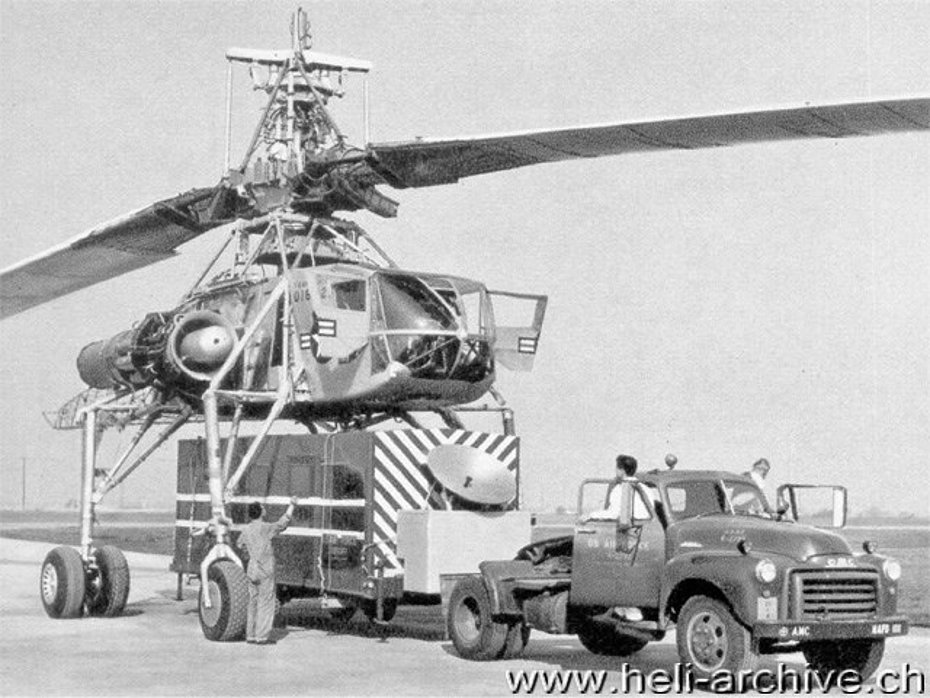Sikorsky S-64A Sky Crane - History and technical description
The idea of using the helicopter as a flying crane was already taken in consideration by the Germans during the Second World War, but the Americans were the first to develop this particular type of aircraft used to lift heavy loads.
Among pioneers Kellett Aircraft Corporation certainly occupies one of the top spots. On May 2, 1947 this American company signed a contract with Air Material Command for the supply of a large heavy lift helicopter designated Kellett XR-17 to be used for short-range heavy duties teorethically capable of carrying suspended loads up to 10 tons .However construction and development of this experimental aircraft, which after the creation of the USAF in June 1948 received new designation of XH-17, was carried out by the Hughes Aircraft Company. In the course of 1948 Howard Hughes took over the XH-17 project after serious financial problems encountered by Kellett.
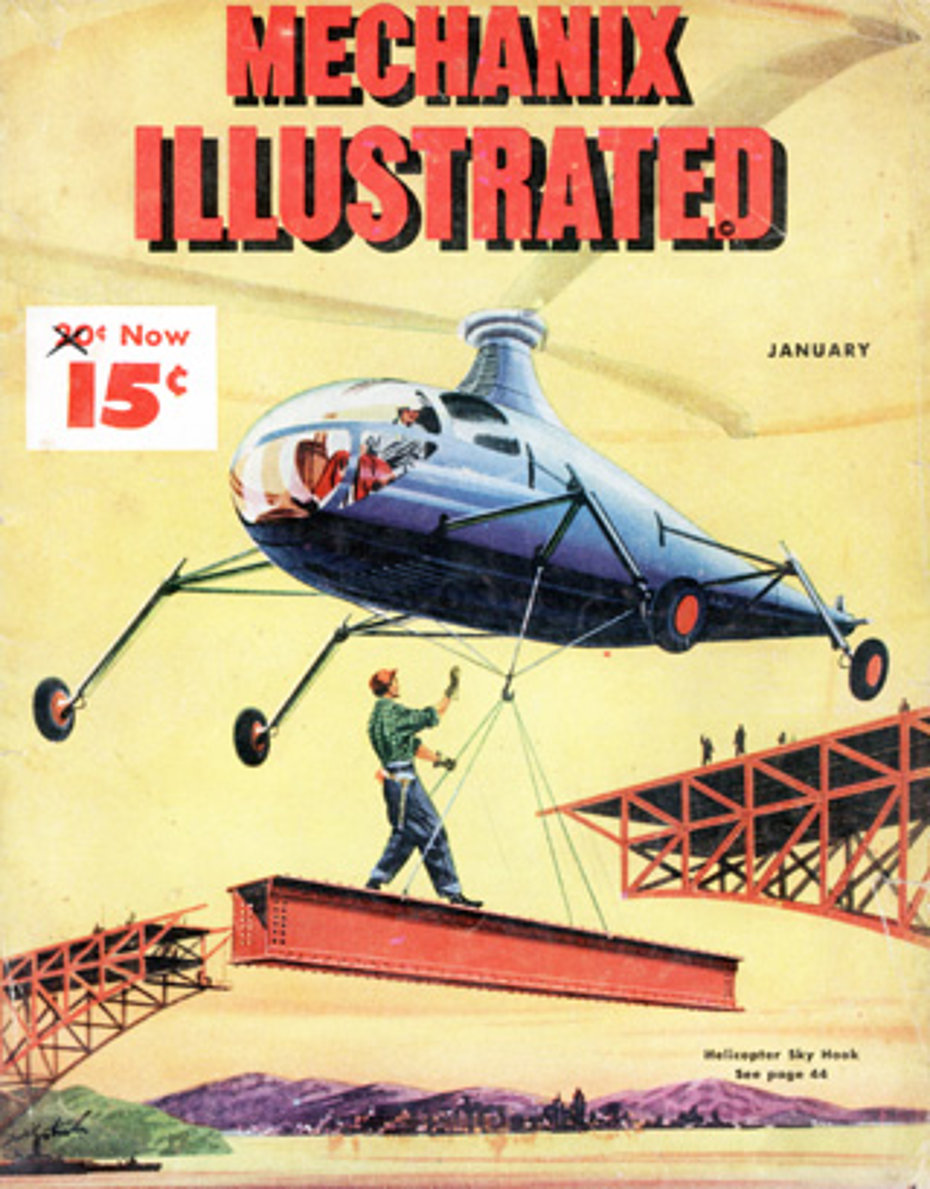
The Hughes XH-17 made its first flight in Culver City (California) on October 23, 1952 piloted by Gale Moore.
At the time of its appaerance this helicopter, assembled using components from different aircraft in order to reduce development costs, was the largest in the world. It had in fact a maximum take-off weight of nearly 20 tons and a main rotor diameter of about 40 meters. This was driven by two powerful turbines General Electric J35 (a true precursor for its time) that sent compressed air to nozzles at the ends of its blades.
Altogether the XH-17 made a dozen hours of test flights (which was in fact the planned service lifetime of the blades!). During a test flight this prototype lifted a suspendend load of 4'665 kg (10'284 lbs). Because of the unsatisfactory results at the end of the test program the XH-17 was dismantled.
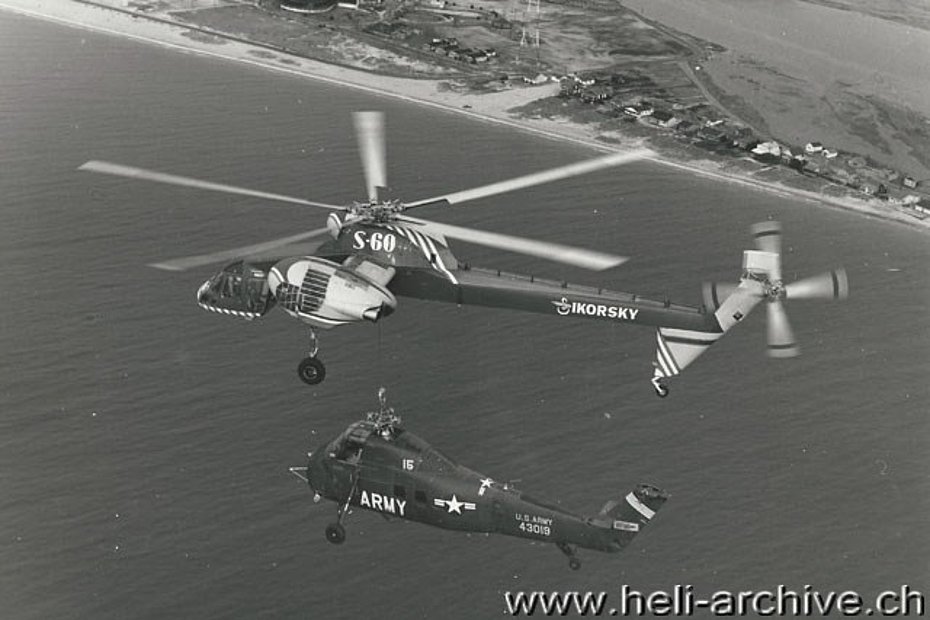
The interest of Sikorsky
After the appearance ot the XH-17 several other manufacturers including Aircraft Omega (Omega BS-12 1956), Mc Donnell (Model 120 1957), Westland (Westland Westminster 1958), or Mil (Mil MI-10 1960), began to show their interest in the concept of the "aerial crane". Sikorsky also appears in the list of the pioneers.
Already in 1955 Igor Sikorsky had spoken publicly about his interest in the development of an "aerial crane." Following his father’s instructions in 1957 his son Sergei made a sketch of a helicopter which was generally very similar to the S-64 Sky Crane.
The following shall aim at describing the actual facts in the correct order to avoid confusion.
In the early ‘50s Sikorsky began the construction in series of the model S-56, a large twin-engine helicopter developed on behalf of the Marines (military designation H-37 Mojave) mainly used as an assault and troop transport aircraft. It was in fact able to carry 26 equipped soldiers and was built in about 150 units.
Birth of the Sikorsky S-60
Sikorsky’s basic idea was to develop a helicopter uniquely designed to carry all loads externally. Following such sketches the concept of the aerial crane was increasingly elaborated and finally brought to the Management of United Aircraft Corporation, who approved company- funding for the design and manufacture of an experimental helicopter designated Sikorsky S-60.
To save weight, cost and maintenance the new helicopter had a simple “stick” structure carrying the mechanical systems with the cockpit suspended below. A particularity introduced on this model was the the aft-facing co-pilot station. With such unusual solution the pilot would have an unobstructed visual, allowing him to observe the entire operation of picking up or delivering cargos. For this reason the co-pilot station could pivot. A characteristic feature of the S-60 was an automatic stabilization system enabling it to hover with precision.
To study the structure conveniently Sikorsky initially built a 1:1 mock-up of the helicopter. Then from May 1, 1958 the design, construction and development phase of the prototype began.
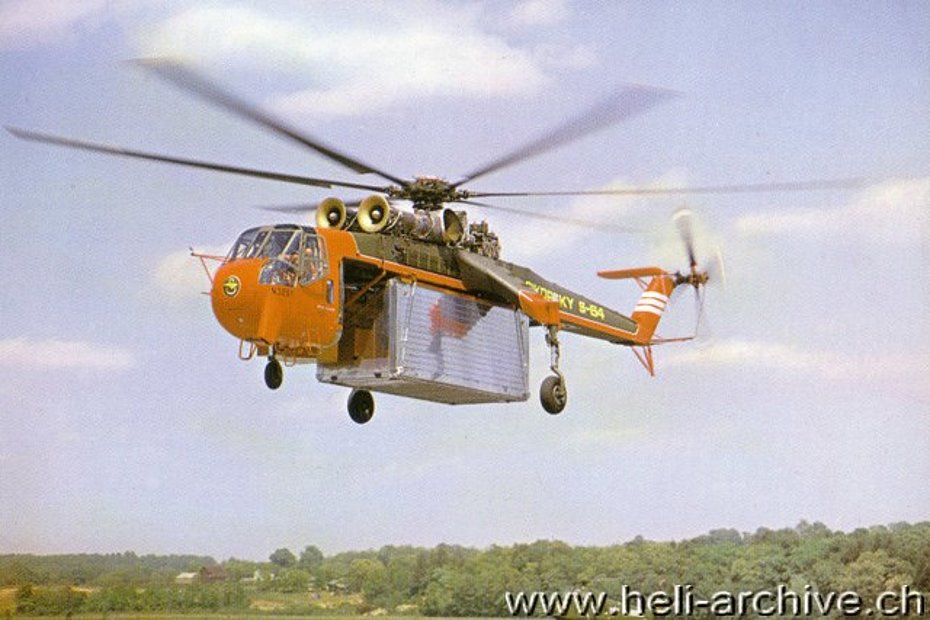
The S-60 was built using the dynamic components of the S-56 including the two piston engines Pratt & Whitney R-2800 18 cylinders double wasp each developing power of up to 1'566/2'100 kW/hp.
The prototype registered N807 made its first test flight on March 25, 1959. In the following two years the S-60 made a long series of test flights and demonstrations. The helicopter was capable of lifting external loadsof up to nearly 6 tons.
After completing 335 hours of test flight on April 3, 1961 during a control flight aimed at checking the sensitivity of controls at low speeds, the S-60 was seriously damaged in an accident which occurred near the Sikorsky plant.
It is interesting to note that this helicopter is currently being under reconstruction and those with an interest in this issue may follow the work carried out via the "Sikorsky S-60 restoration" facebook page.
Overall the Sikorsky S-60 proved to be a good aircraft and it was right on the heels of this success that even before the accident the design office had the idea of creating a new version designated as S-64. The management of the company formally approved the start of the design work in September 1959.
The development of the Sikorsky S-64
During the ‘50s and ‘60s (in the Cold War period) several Nations all over the world designed and developed VTOL/STOL aircraft. In the event of an attack, both in the past as well as now, airports are in fact among the main targets to be destroyed in order to prevent runways being used by the enemy.
In Germany, where the NATO airbases were vulnerable to a sudden Soviel attack, some VTOL jet aircraft were also being developed. This kind of aircraft could in fact be used from remote or hidden places. However, this meant that there was a need to frequently supply such improvised bases with fuel, ammunition and equipment.
With regards to this issue, NATO held a tender and the S-64 project was declared the winner.
For this reason from the beginning of 1959, thanks to an agreement with the Sikorsky Aircraft Division of the United Aircraft Corporation (UAC), a group of about twelve German technicians employed by the Weser Flugzeugbau (WF), participated in the design and development of the new helicopter. It should be noted that in the course of 1961, WF was incorporated into Vereinigte Flugtechnische Werke GmbH (VFW) along with Focke-Wulf Flugzeugbau, in which the UAC also had financial interests.
The agreement also foresaw the supply to the German Federal Ministry of Defense of two prototypes (s/n 2 and 3) which were delivered in the beginning of 1963.
In spite of the fact that the general aspect was a reminder of its predecessor, the Sikorsky S-64 had its own peculiarities such as for example: replacement of reciprocating engines with more powerful and lighter (395/877 kg/lbs instead of approximately 1'065/2,347 kg/lbs) turboshaft, new transmission, new six-blade main rotor of a larger diameter, modified landing gear, a larger cabin, new cargo hook of higher capacity, a levelling system to hang and balance suspended loads, an APU (auxiliary power unit), elimination of a part of the fairings in order to reduce weight, cost and maintenance, addition of a control system for the load master (replacing the rotating seat of the co-pilot).
The prototype of the Sikorsky S-64 registered N325Y (s/n 64-001) made its first flight May 9, 1962.
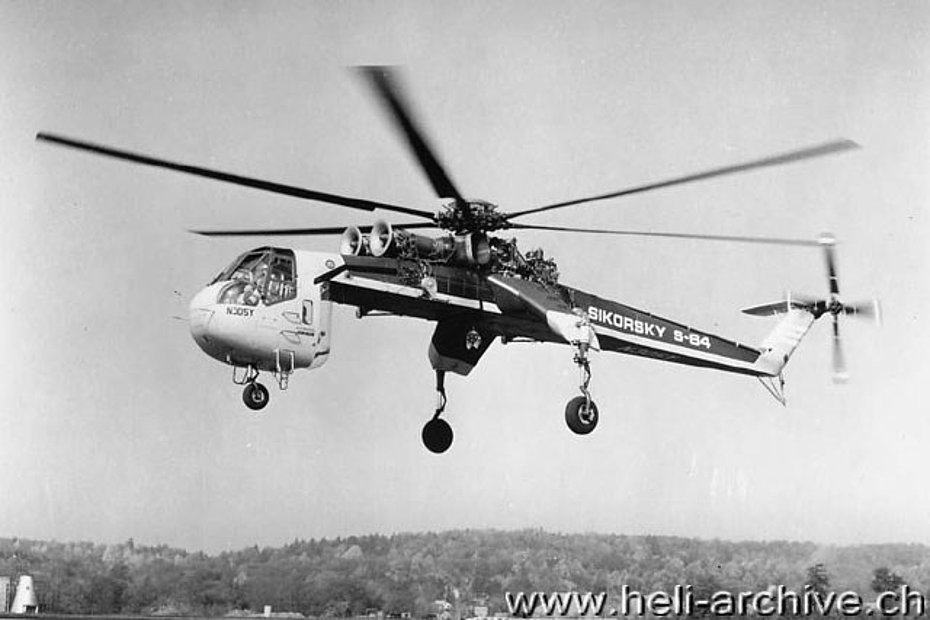
Later two more prototypes registered N305Y (s/n 64-002) and N306Y (s/n 64-003) were completed. Following the success of the first flight demonstrations, in June 1963 the U.S. Army announced that it had ordered six S-64 which obtained the military designation YCH-54A and much later CH-54 Tarhe (see note 1).
During the early summer 1963 the prototypes N305Y and N306Y were delivered to the Army Aviation in Germany and received the civil registration D-9510 and D-9511.
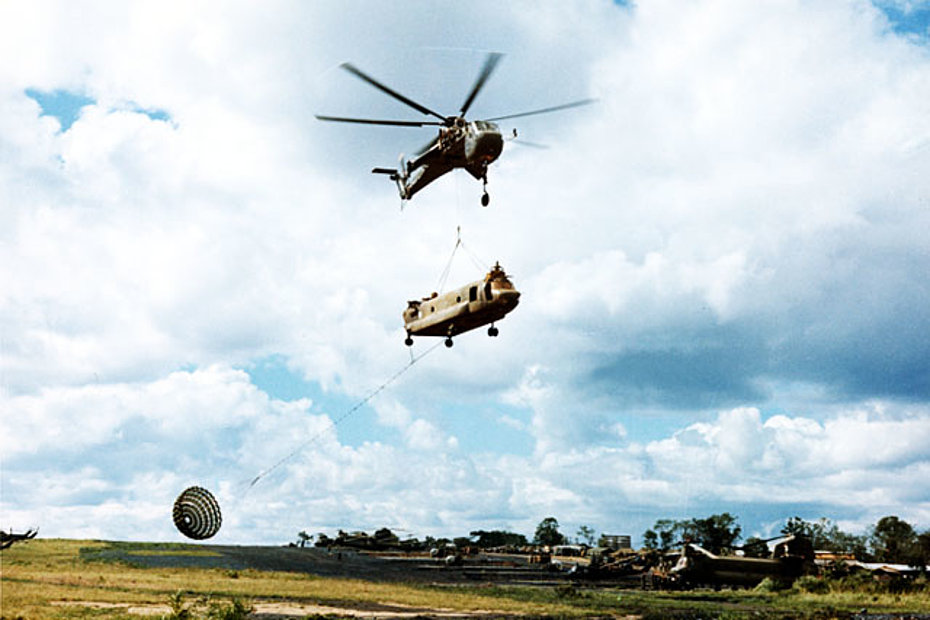
These helicopters were at first tested in Buckeburg and then in Oberpfaffenhofen. Later the S-64As were tested in Oberjettenberg near Bad Reichenhall (Bavaria), a mountain military base used by the Bundeswehr. For the the final stages of the evaluation program the S-64s were transferred at the air base of Fürstenfeldbruck used by the Luftwaffe since 1936.
The US-German agreement provided, in addition to the supply of the two aircraft, the rights for production in series of this model.
The CH-54 in Vietnam
After initial extensive testing the CH-54 was sent to Vietnam where it was successfully employed, especially for the transport of weapons and ammunitions, heavy vehicles such as excavators, bulldozers, trucks, boats, bridges, and supplies of all kinds.
The use of the helicopter proved to be very valuable for downed-aircraft recovery. In a document dated December 24, 1968 the US Army reported that of the 423 aircraft rescued until that moment (with an estimated value of more than 220 million U.S dollars) 105 were so large as well as so heavy that only the powerful CH-54 Tarhe was able to pick them up from otherwise inaccessible places.
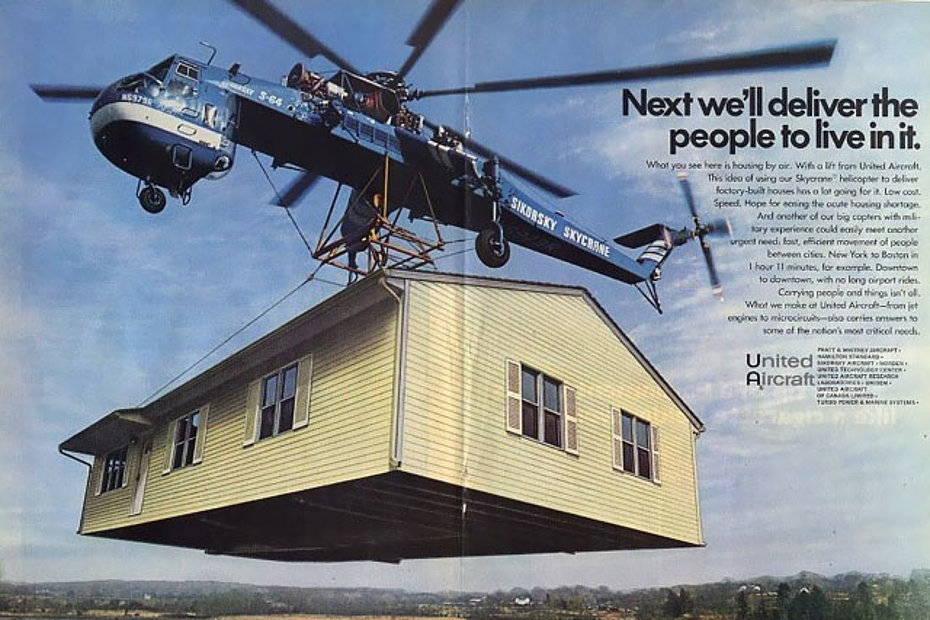
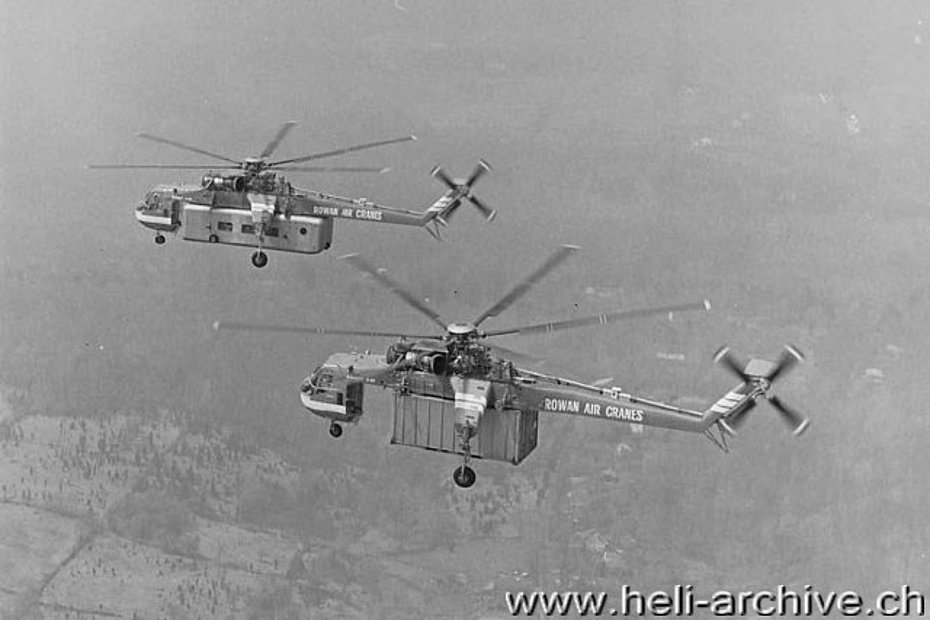
Altogether Sikorsky has produced around one hundred S-64/CH-54A.
Over the years the S-64/CH-54 has established numerous climb and altitude records. On November 4, 1971 a CH-54B reached an altitude of 11'010 m (36,133 ft), a record for this class of helicopters and which still remains undefeated.
The U.S. Army withdrew its Tarhe from active service after thirty years. Several aircraft were then converted for civilian use.
The S-64 for civilian uses
The Sikorsky S-64A has found wide employ in the civil market. Over the years, this aircraft has proved itself to be a highly versatile, reliable, and cost-effective workhorse in the construction, petroleum and logging industry as well as being an essential fire-fighter all over the world.
On June 30, 1965, the FAA released civil certification for the CH-54A.
It was not long before the largest helicopter operators would realize the enormous potential provided by the powerful S-64.
Between 1966 and 1967 the Sikorsky Commercial Operation Team carried out a long series of flights in North and South America. For example during this promotional tour the helicopter was used to transport supplies from ships to land, construct power lines, oil rigs, or for logging and fire-fighting operations.
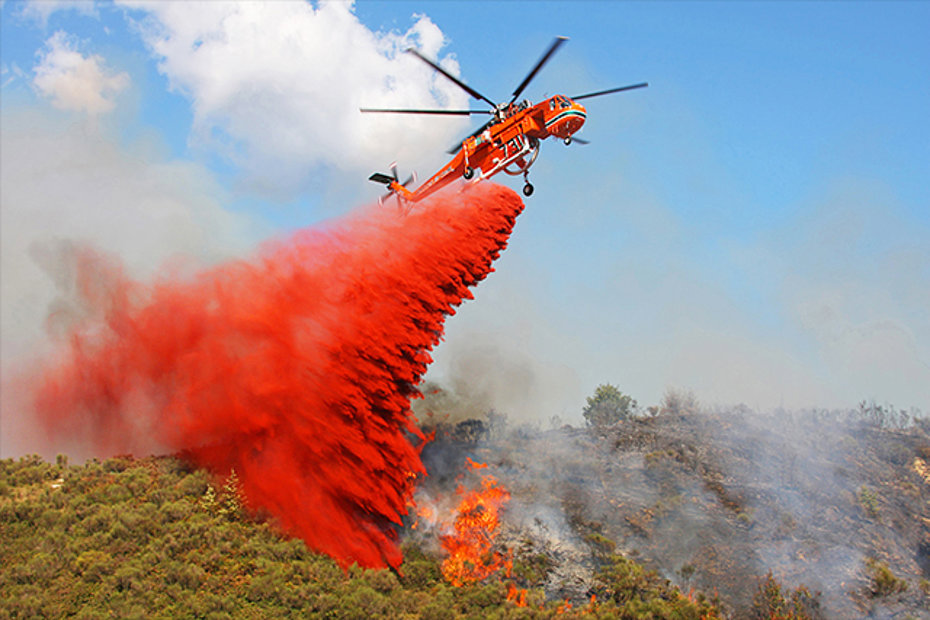
On February 15, 1968 Sikorsky announced the development of the S-64E a version specifically designed for civil use powered by two Pratt & Whitney JFTD12 -4A turboshaft which received civil certification on August 21, 1969.
Rowan Drilling Company Inc. of Houston, Texas was among the first to purchase the "flying crane". On April 18, 1969 this company bought two S-64Es and used them in Alaska to transport heavy drilling equipment.
A prominent place among civil users of the Sikorsky S-64 is owed to Erickson Inc. (formerly Erickson Air-Crane Company) holding its headquarters in Portland Oregon.
In January 1972 the large helicopter operator hired the first S-64E for logging operations.
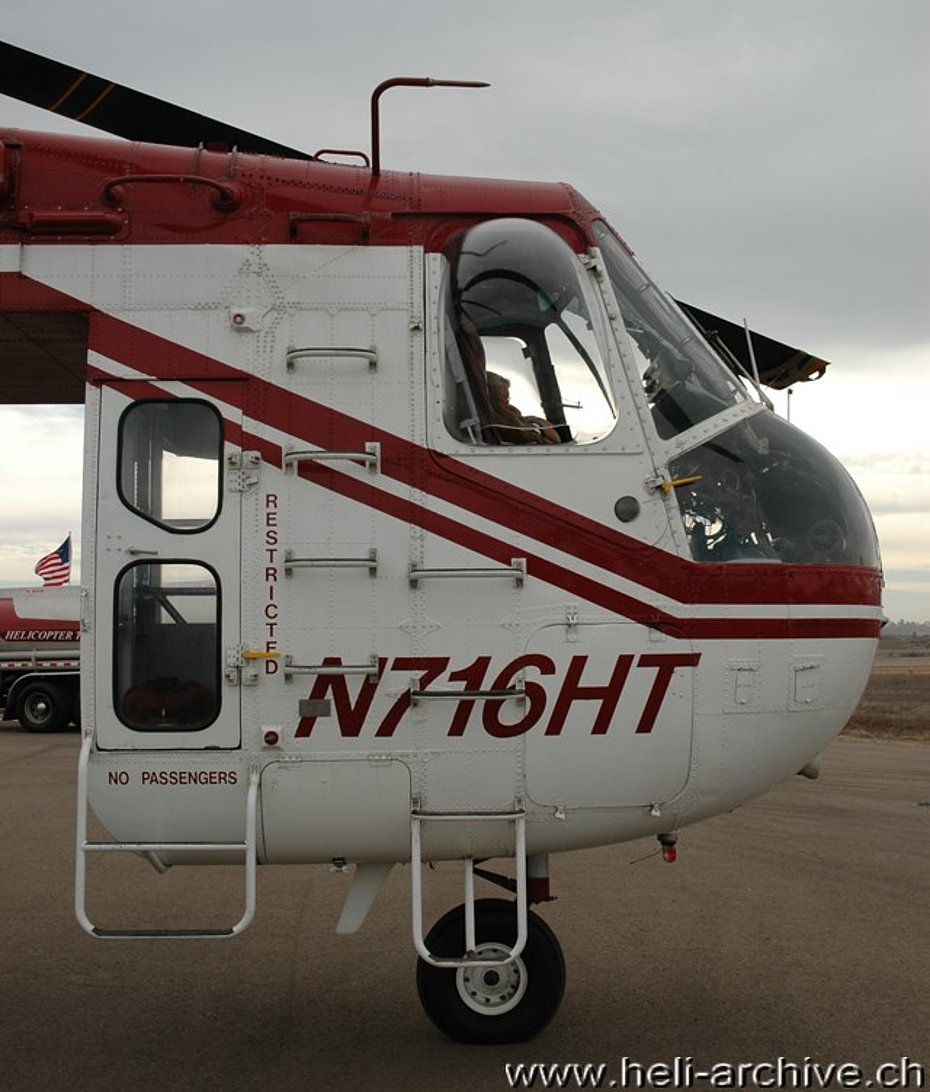
On February 1, 1992 Sikorsky agreed to sell Erickson the S-64 Sky Crane Type Certificate. Sikorsky also transferred all manufacturing and support rights worldwide for the 10-ton payload S-64E and the more powerful S-64F which has a 12.5-ton payload. Over the years Erickson engineers converted various military aircraft for civilian use. This company also introduced many changes and modifications and developed new equipment to extend the versatility of this aircraft.
Nowadays over fifty years since its first flight the S-64 Sky Crane continues to carry out its heavy work.
Among the most delicate missions assigned to this aircraft to mention the removing and replacing the Statue of Freedom, which sits on top of the United States Capitol dome in Washington D.C.
Using its precision manoeuvring capability a S-64F in service with Erickson Inc. lifted the statue off of its pedestal on May 9, 1993, and placed it back after much needed renovation on October 23, 1993.
Despite having made its first flight more than fifty years ago, there are still many S-64s in service.
Technical description
Firstly it is important to mention that there are different civil and military versions of the Sikorsky S-64 Sky Crane. All the versions are quite similar, in spite of the fact that they have different engines, performance and payload. The following description refers to the S-64A which obtained the FAA Type Certificate H1EA in the restricted category on July 30, 1965. One of the main features of this aircraft is the fact that it was one of the first to be built in modules. Cabin section, drive train and fuselage were interchangeable units, which could easily be replaced on the field.
The six-blade main rotor is fully articulated, while the tail rotor has four blades. On the axis of the tail rotor there is a horizontal stabilizer. A tail skid is included to protect the tail in an extreme nose-up landing. When necessary it can be retracted for positioning of the cargos under the fuselage easily.
The “pod and boom” fuselage is made of aluminum and steel.
Most of ths major components such as turboshafts, transmission and drive shaft are not protected by cowlings. This extremely simple solution reduces costs, empty weight and facilitate maintenance work.
Crew members climb ob built-in steps from the landing gear to the fuselage. Flat fuselage top doubles as a work platform.
The electronic components are located in the nose for waist level access.
There are two models of cabin: the large one (which accomodates a crew of five) and the short one (4 places).
In the large cabin there is the place for the pilot (seated on the right), co-pilot (seated on the left side) and a jump seat between, all in front, while behind them in a lower position there is the third aft-facing pilot station. The fifth crew-member has a small jump-seat on the right hand side aft, facing to the left.
The S-64 aft-facing pilot’s station is believed to be the first to use a fly-by-wire system on a helicopter. From this position it is possible to make fine corrections to place in position and release suspended loads. The pilot in the auxiliary control station has a complete set of controls which includes a joystick (cyclic control), collective pitch and a manual control of the pedals which may be switched off.
Although FAA does not require a qualification as pilot on the S-64 for this operator, according to the information gathered the few who maneuver the helicopter from the “crane operator seat” are all S-64 pilots with great experience in aerial work.
Access to the cabin is via a fixed ladder on the right-hand side and through an aft door always on the right-hand side.
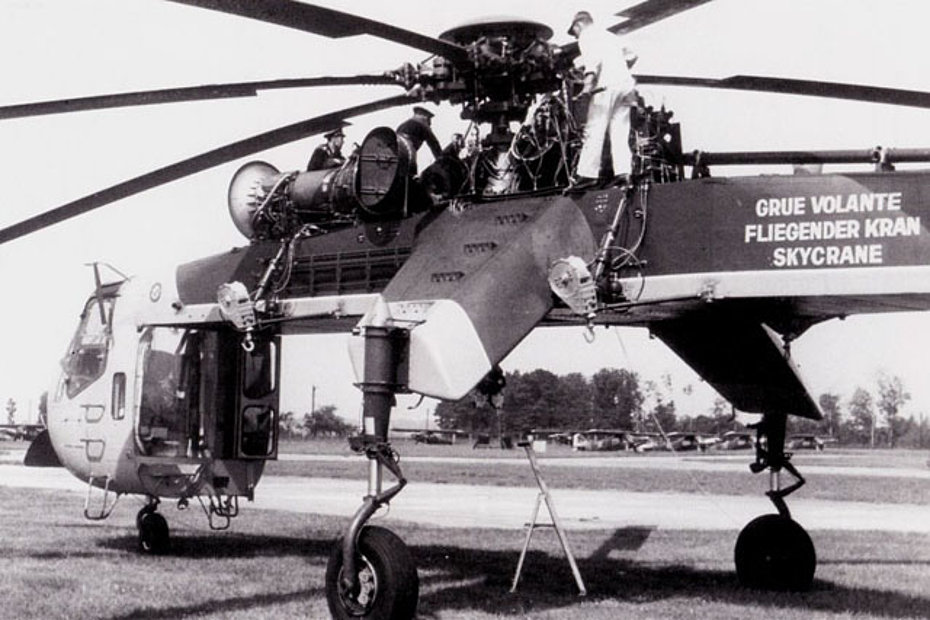
Unlike the S-60 the tricycle landing gear has a nose fixed wheel. This makes ground maneuvering around the payload easier. Trucks for example can drive righ up to the point of pick-up.
The S-64A has a single point 9,072 kg (20,000 lbs) capacity hook which is suspended to a steel retractable cable. This allows the load to be moved up and down while the aircraft is hovering. The hoist cable is fed to the drum by a compensator linkage that automatically adds or reduces the collective pitch to help hold vertical position. Moreover there is a system of four small hoists of 2,268 kg (5,000 lbs) capacity each to support the cargo in a different configuration.
To further improve cargo handling on the ground, the landing gear could kneel over the load to facilitate attachment and detachment phases.
The wide track and the ample vertical clearance allows bulky loads such as vehicles, containers or prefabricated structures (e.g. mini field hospitals, radio stations, etc. ) to be easily set in position. Various types of universal cargo/personnel pods were built in order to extend the versatility of the aircraft. These could be used for the transport of personnel and equipment. Some were modified to be used as a command post, communication center or surgical unit: https://www.youtube.com/watch?v=RAltpRp06Uk
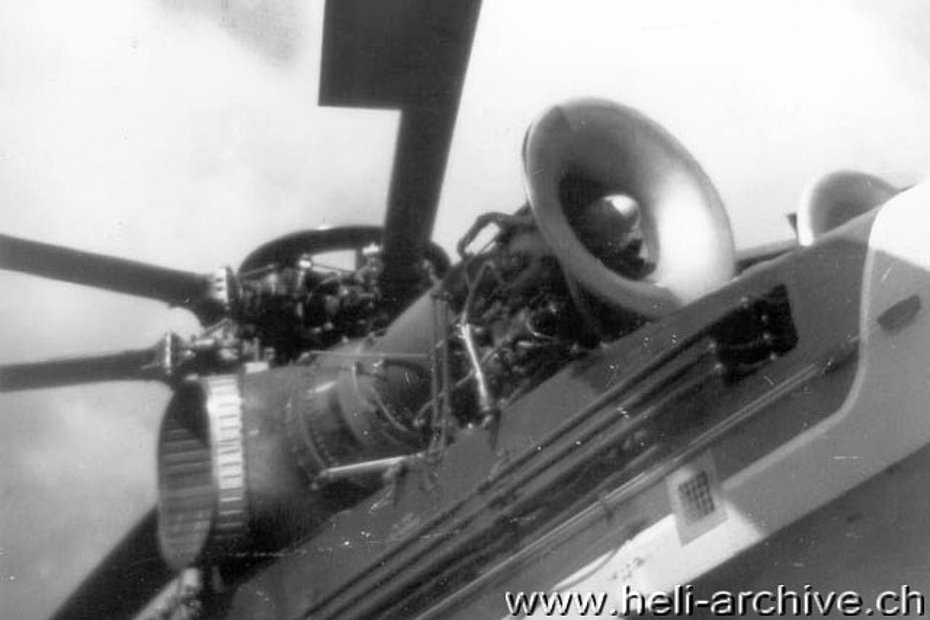
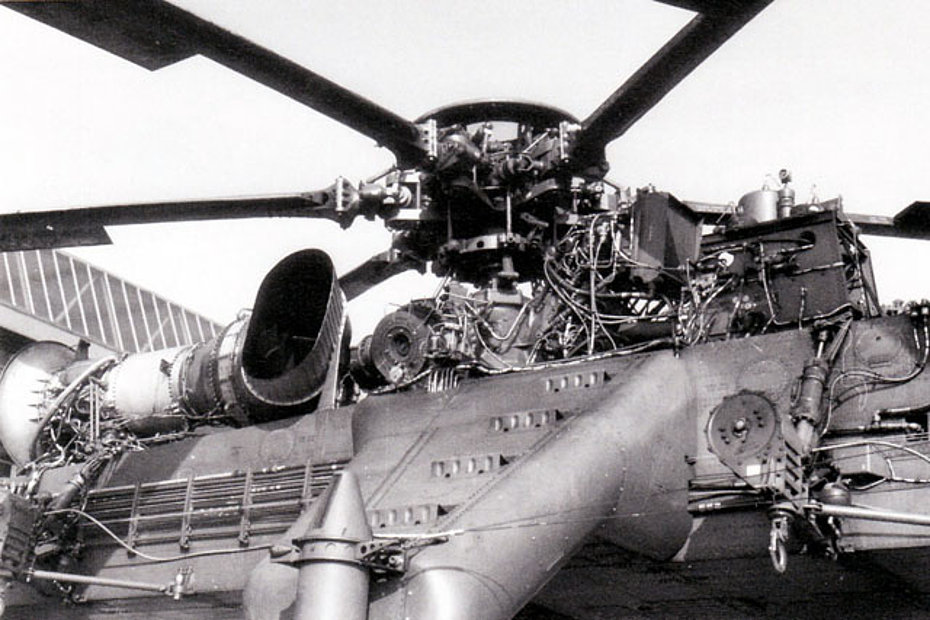
The S-64A was equipped with two Pratt & Whitney JFTD12A-1 turboshaft engines each with a maximum take-off power of 2'997/4,050 kW/hp and a maximum continuous power of 2'368/3'200 kW/hp.
The helicopter has two fuel tanks in fuselage, forward and aft of the main transmission, each of 1'664 liters (440 USG). Total fuel capacity is 3’328 litres (880 USG).
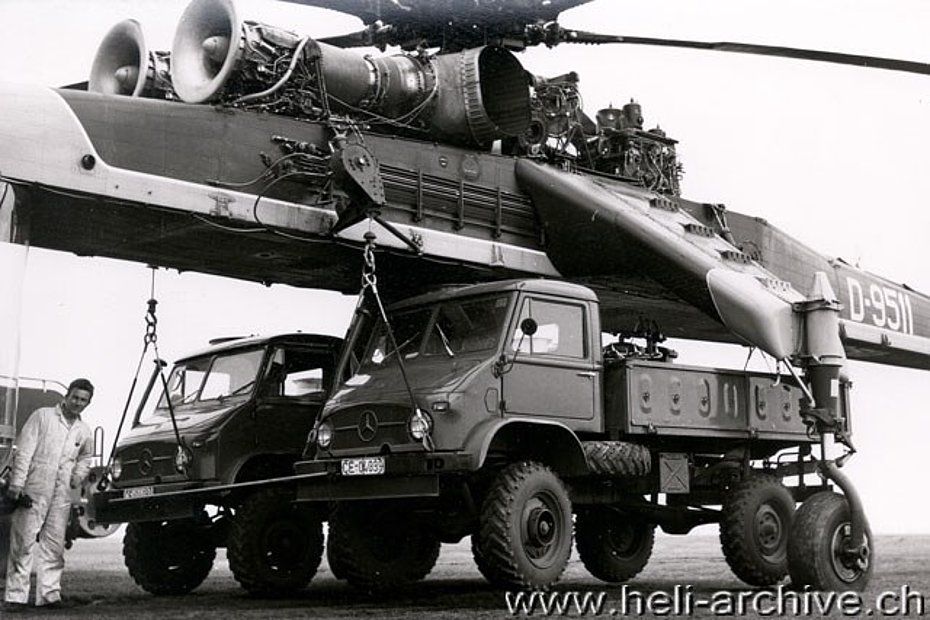
Dimensions, weights and payload
The main rotor has a diameter of 21.95 m (disc rotor area 378.1 sm), while its tail rotor has a diameter of 4.88 m (rotor disc area 18.67 sm. The fuselage has a length of 21.47 m. The height measured on top of the rotor mast is 5.67 m. The cargo compartment below the fuselage has a width (measured between the landing gear legs of 5.65 m and a vertical clearance of about 4.20 meters. The standard empty weight of the aircraft is about 8’845 kg (19’500 lbs), while its maximum take-off weight is 17’420 kg (38’000 lbs). The maximum external payload is 8’000 kg (17’636 lbs).
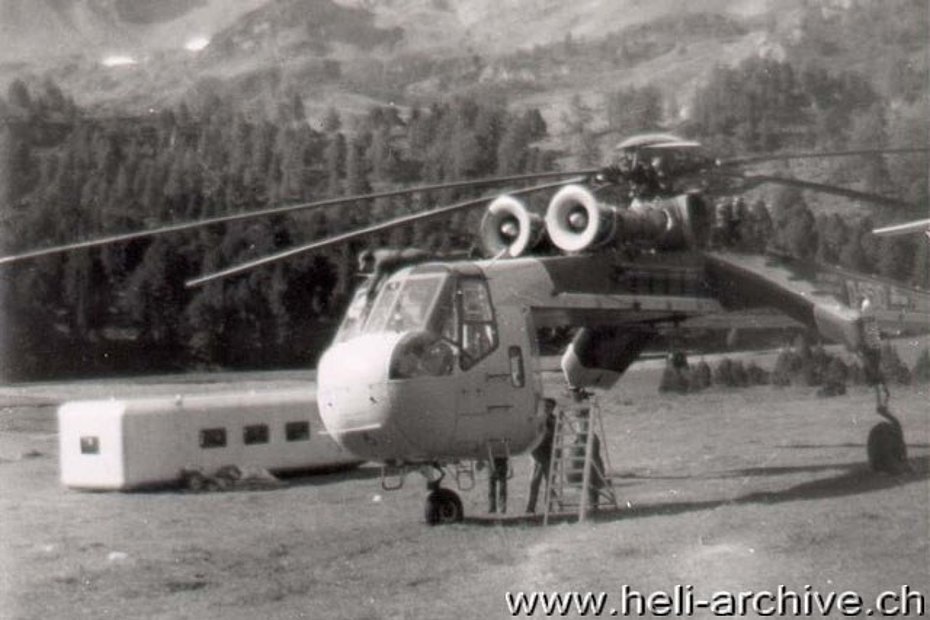
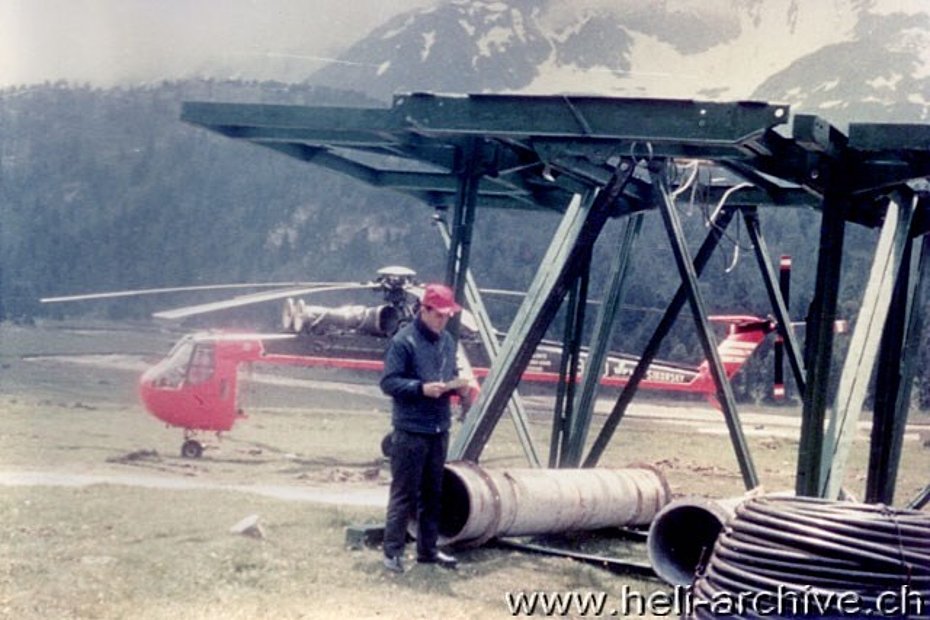
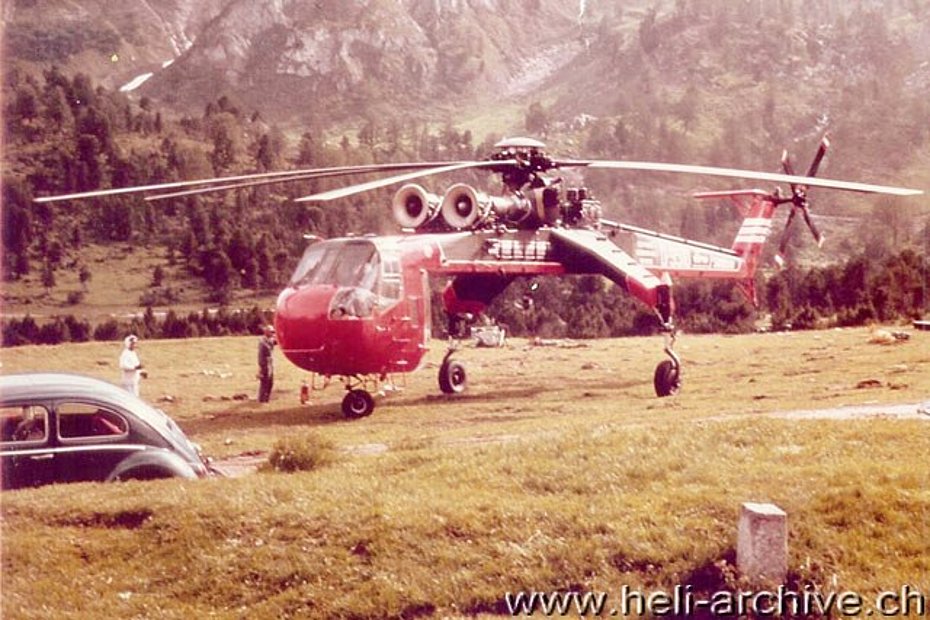
The Sikorsky S-64A in Switzerland
In the early 1960s the Swiss Confederation was researching issue of Alps crossing with a modern and fast rail link.
In 1961-1962 on behalf of the "Gotthard tunnel Research Committee" of the Federal Department of Transport, the Elektro-Watt company of Zurich developed the project of a basis tunnel under the Gotthard rocky surface 45 km in lenght, which is approximately the distance between Giornico (Canton Ticino) and Amsteg (Canton Uri).
In order to accurately establish the duration and cost of the work to be undertaken (which was estimated as 783 million Swiss Francs), the aforementioned group needed to collect data on the characteristics of the subsurface in the an alpine region known as "Sacca di Piora" located between two granite masses (Gotthard and Lukmanier).
In that region there was is fact the risk of finding the dolomite rock, a sedimentary carbonate rock that contains a high percentage of mineral dolomite similar to sugar. This rock, feared by miners, had already created problems during the excavation works of a hydro tunnel in Val Canaria (in the proximity of the alpine lake Ritom point of departure for those passionate about hiking and biking excursions in the Piora valley).
The likely presence of dolomite rock could lead to a considerable increase of excavation work and consequently relative costs.
Under the guidance of the notable Ticino Professor Ezio Dal Vesco, Scientific director of ETH Zurich Department of Geological Studies (ETH is one of the leading international universities for technology and natural sciences), the Federal Department of Transport decided to finance a series of drilling work.
Of course the main drilling point was selected as a result of its geological location along the track of the planned tunnel. This area in the upper part of the Blenio valley is known by the local name of "Gana Bubaira". The selected drilling point lies at an altitude of 2,180 meters (7,150 ft) and was not served by roads.
The only alternative to helicopter transport for the rig, crew quarters for 20 men, draw-works and all the ancillary stores would have been the construction of expensive lorry roads or cableways leading to inevitable negative impact on the environment.
The organization
Elektro-Watt entrusted Heliswiss AG, a true pioneer in Switzerland in this kind of activity, with the organization of transportation.
Due to the political assistance of the Federal Office of Transport Heliswiss was able to obtain permission to rent one of their two Sikorsky S-64A from German authorities.
In spite of the fact that exactly fifty years have passed since those events, thanks to a series of fortunate circumstances I managed to trace Ulrich Heider who was employed at the Weser Flugzeugbau.
Mr. Heider (class 1933) is an aeronautical engineer who personally took part in the operations on the Lukmanier Pass. Thanks to his help and memories it was possible to describe the events in detail.
On the Lukmanier pass
Preparation works began in the spring of 1964 when the Mancini and Marti building company prepared in "Gana Bubaira" the foundations for the construction of the barracks for the personnel and the drilling platform.
The building material necessary for the construction of the barracks was transported by the Agusta-Bell 204B and 47 in service with Heliswiss. Towards the middle of June (1964) everything was ready.
At this point the Sikorsky S-64A was called on the scene for the transportation of the heavy drilling platform and its accessories (total weight around 114 tons).
The German drilling company Haniel and Lueg of Düsseldorf transported all of the drilling equipment (which was accurately weighted) on the Lukmanier pass by truck. The equipment was then neatly placed in a meadow beside the road that leads to the pass in the proximity of the Alp Casaccia at an altitude of 1,820 meters.
On Saturday, June 20 the Sikorsky S-64A registered D-9510 (s/n 64002) left its air base in Oberpfaffenhofen southwest of Munich and flew to Friedrichshafen on the northern shoreline of Lake Constance (the Bodensee) in Southern Germany, near both Swiss and Austrian borders. The five-men crew consisted of pilot Jack Porth (Sikorsky), co-pilot Heinz Hofmann (VFW), flight- engineer Ulrich Heider and mechanics Helmut Thiele, crew chief and Hermann Gericke, quality inspector (all employed by VFW).
The D-9510 was chosen for the simple reason that it was equipped with less electronic equipment and consequently it was 426 kg (939 lbs) lighter than the D-9511.
All the necessary equipment and tools for the maintenance on the field along with the crew luggage was transported in the special pod built by VFW which was attached under the cabin of the helicopter.
When customs formalities were completed the helicopter left Friedrichshafen and crossed the German-Swiss border. Few minutes later it landed on the Altenrhein airport (Switzerland) where the crew despatched other customs formalities this time with personnel employed by the Swiss Federal Customs Administration.
Early that afternoon the crew took off from Altenrhein and headed for the Lukmanier pass where it landed about one hour later.
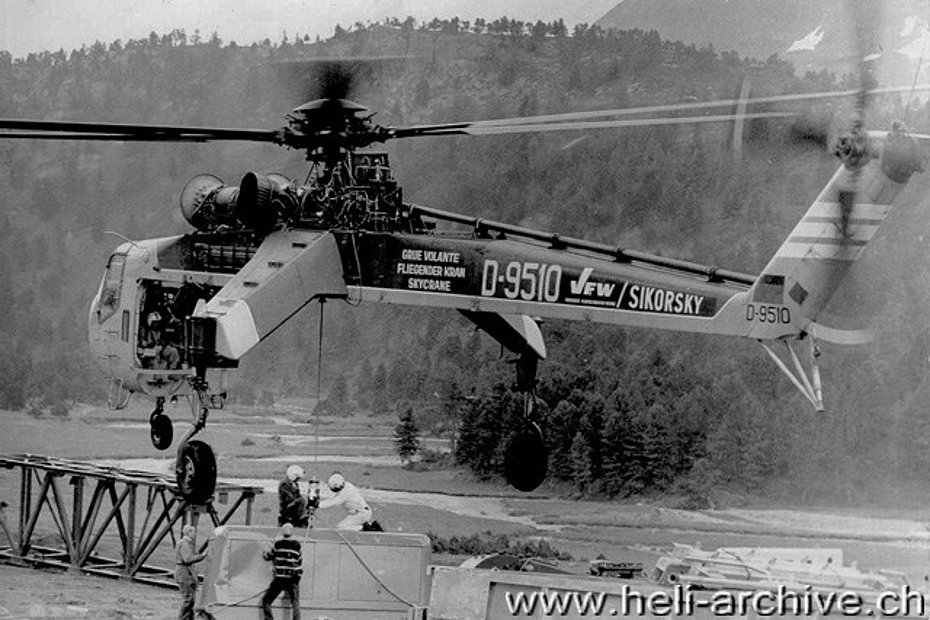
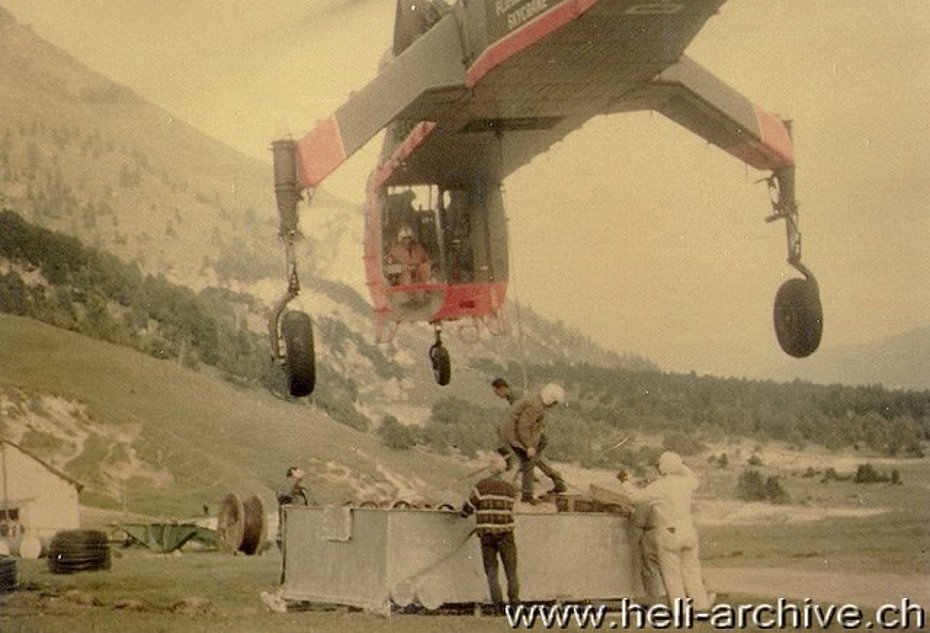
After the Sunday rest, on Monday June 22, the helicopter was prepared for its heavy workload. While the pod was detached the flight assistants carefully prepared the heavy loads and examined the work program once again.
When preparations were completed the helicopter tuboshafts were switched on. During the air transport operation the crew was made up of Porth, Hofmann and Heider.
In the course of the first day of work the helicopter flew 2h34min and completed 24 flights carrying a total of 87.4 tons of equipment. During the fifth rotation it lifted one of the heaviest loads, one of the two bases of the drilling station weighing 6'980 kg/15’388 lbs (total weight of the helicopter inclusive payload 16'330 kg/36’000 lbs).
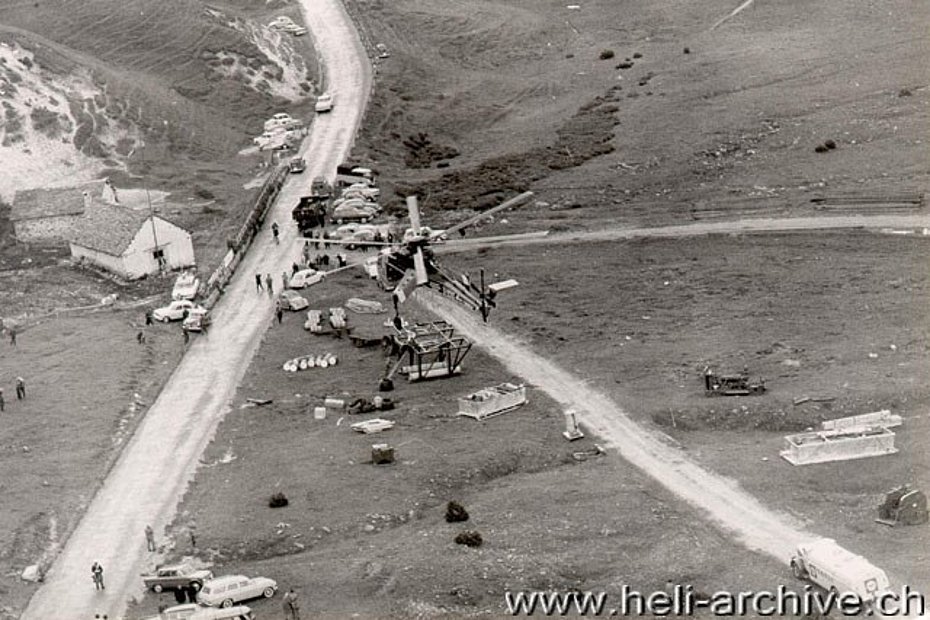
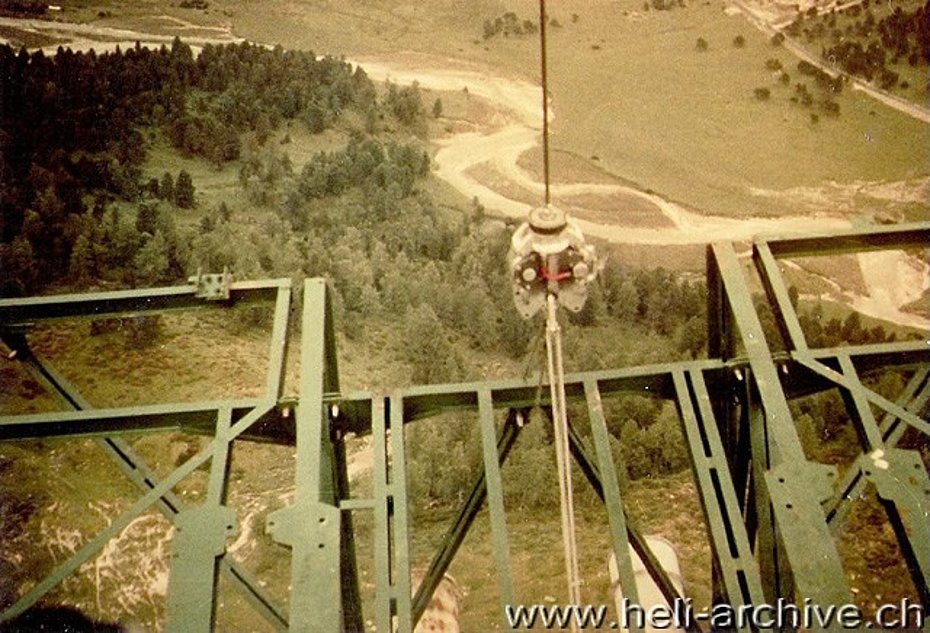
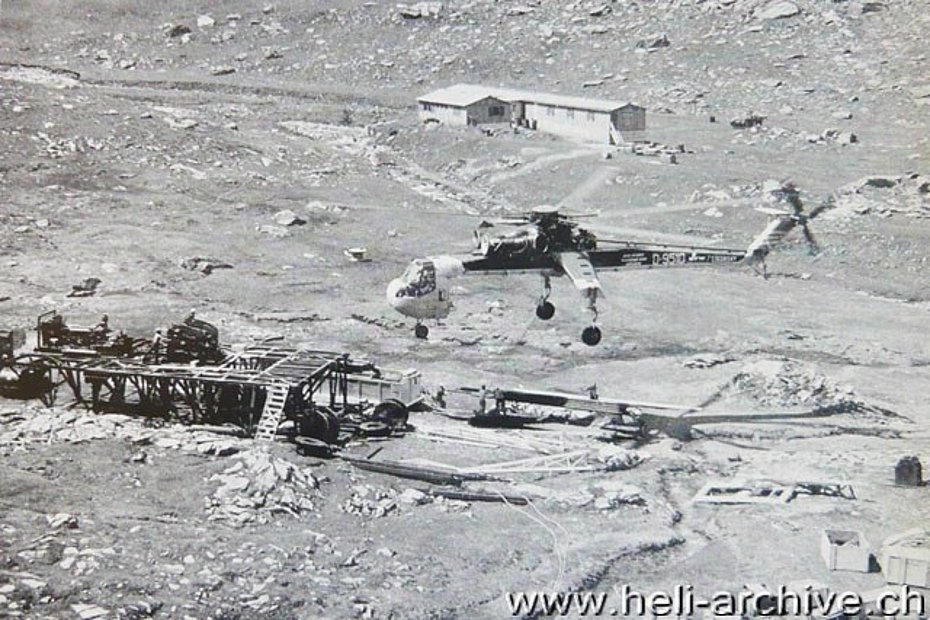
Several other elements largely surpassed the weight of 6 tons. For this reason, the helicopter flew with a limited fuel reserve, and every three to four rotations it landed to be refuelled with kerosene.
The equipment was lowered in precise sequence so that assembly could begin at once. For example the heavy gear shafts for the rig machinery were inserted directly into the gears by the hovering aircraft, and sections of the derrick were bolted together while still suspended.
On Tuesday June 23, the helicopter did five more rotations lifting a total weight of 27 tons of material in 33 minutes.
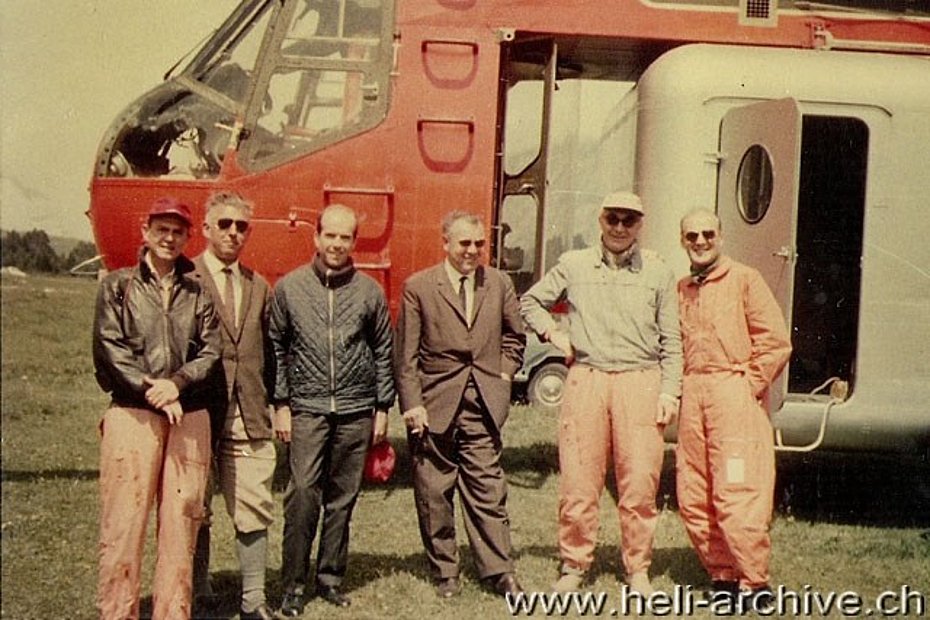
All the transportation operations were carried out with favourable weather conditions and followed by a large audience which rushed to the spot to see what the Ticino journalist Giuseppe Biscossa described as the "colossus of the skies, abnormal for its giant dimensions and look".
In the early ‘60s the helicopter was not yet very popular in Ticino, therefore we can easily understand people’s amazement.
The S-64 was obviously the largest so far that had appeared in the Ticino skyies.
Heliswiss invited several major Swiss companies, the military authorities, press and media.
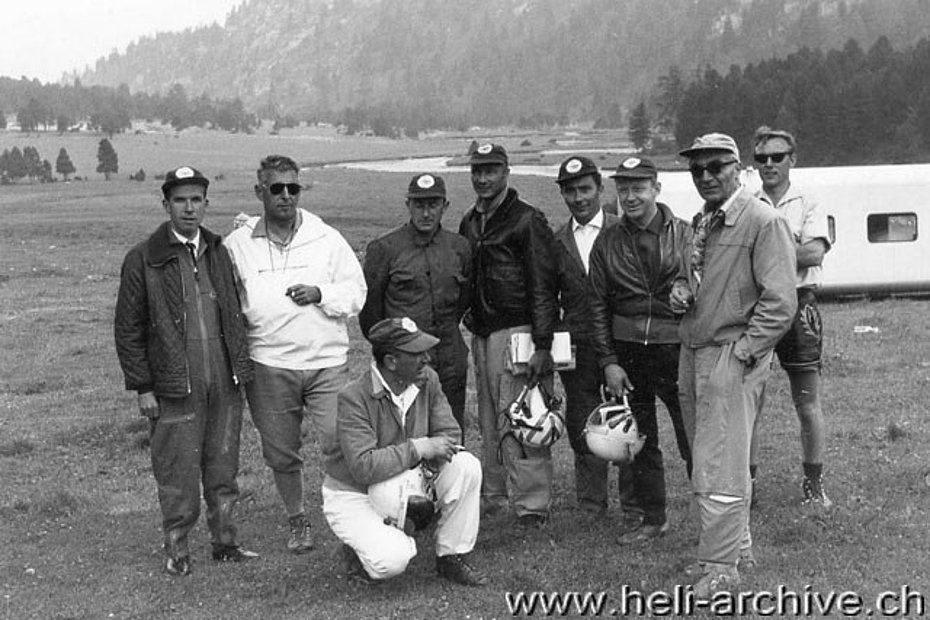
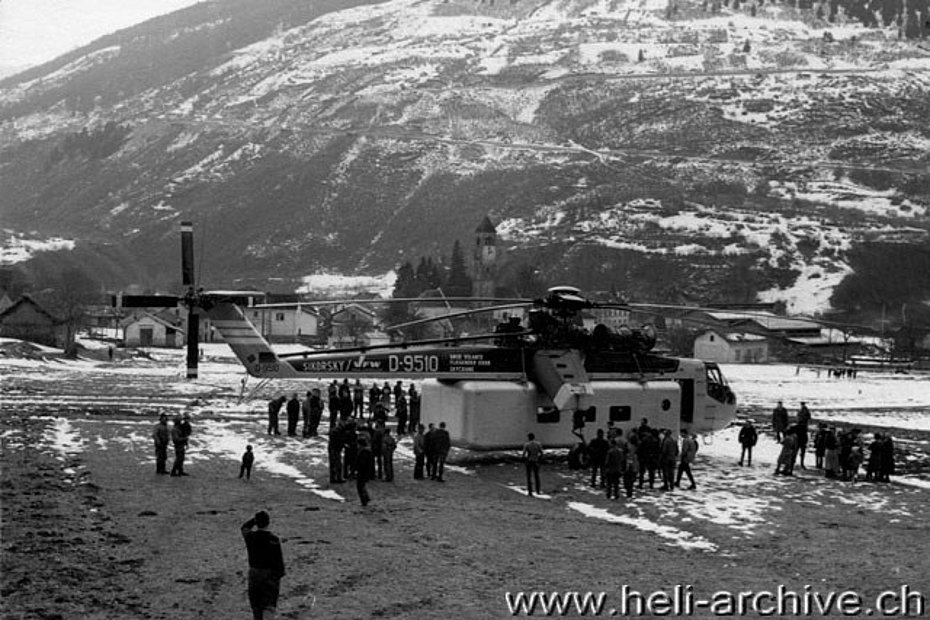
Back to Ticino
In January 1965 the Sikorsky S-64A D-9510 reached the Lukmanier pass again to replace the engine and the accessories of the drilling station. Only few rotations were required in that circumstance.
The drilling station in Gana Bubaira was completely dismantled in July 1965 at the end of the drilling work.
On that occasion the Sikorsky S-64A was flown by the American pilot Albert King accompanied by the previously mentioned Hofmann and Heider.
Unfortunately Albert King passed away in a flight accident on May 19, 1978 while testing the prototype of the Sikorsky YUH -60A Black Hawk 73-21650 prototype.
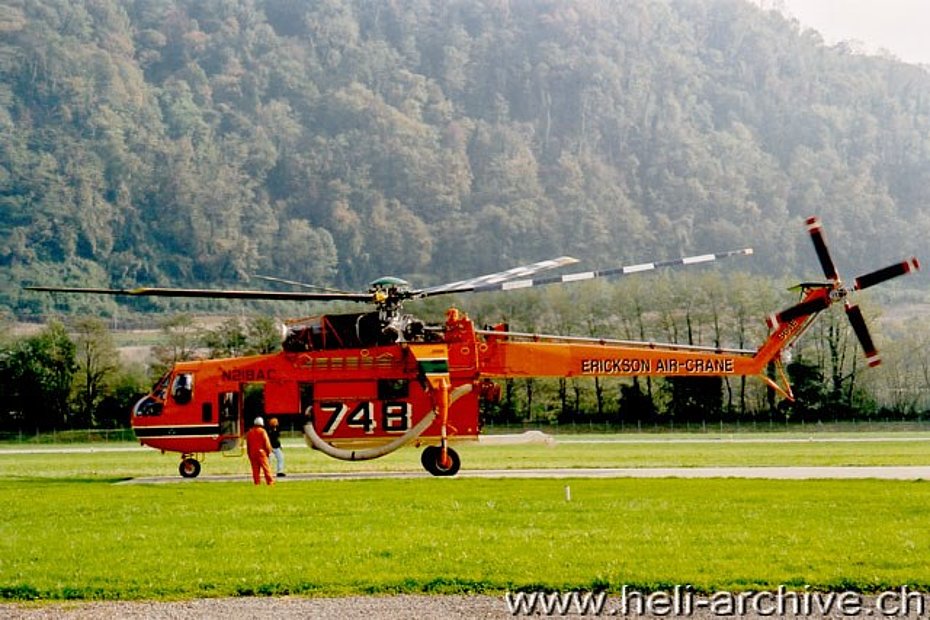
Epilogue
On September 30, 1965, at the end of the evaluation period of the two prototypes D-9510 and D-9511, which in the meantime had been registered as LA+112 and LA+113, the two helicopters continued to serve with the German armed forces until 1968, after which they were returned to Sikorsky.
In place of this model, the German army decided to buy the Sikorsky CH-53G, a multi-purpose aircraft capable of carrying loads of up to 8 tons, or 37 equipped soldiers which is essentially a fully faired version of the S-64.
This helicopter may often be seen in Switzerland, especially on aviation meetings. Instead, it is very rare to see a Sky Crane in Switzerland.
On October 22, 2000, the S-64E Sky Crane N217AC nicknamed "Elsie" made a stopover at Lugano-Agno (Ticino) airport. Despite the fact that the event had not previously been announced however the aircraft immediately attracted a small crowd on onlookers among which of course myself!
Interesting facts
In the ‘60s other manufacturers invested their energy in the study of large flying cranes. In Germany Bölkow designed the Bölkow BO70 having a theoretical payload of 40-50 tons, while Dornier designed the P406 (40 tons) model.
However in the category of so-called Heavy Lift Helicopters (HLH) the top place is occupied by the Russian Mil MI-26 Halo, a giant machine capable of lifting up to 20 tons or 80 equipped soldiers built in hundreds of units.
The career of the Sikorsky S-64 Sky Crane with the US-Army was obscured by the appearance of the Boeing CH-47 Chinook which made its first flight September 21, 1961 and was produced in over 1’200 units.
Notes
Note 1 - This nickname pronounced Tar'-he was the name of a tribal native American Chief of the Wyandot People of North America who used his influence to keep peace between native and white people. Chief Tar-he was very tall and the French settlers used to call him “The Crane”.
Special thanks
This article (in which I invested around 250 hours of work!) was prepared thanks to the help of the following people:
- Dan Libertino, President, Sikorsky historical archives: www.sikorskyarchives.com
- Ulrich Heider, Hamburg Germany
- Rudolf Renggli, Toffen
- Brent Wallace, Vancouver
HAB 06/2014


